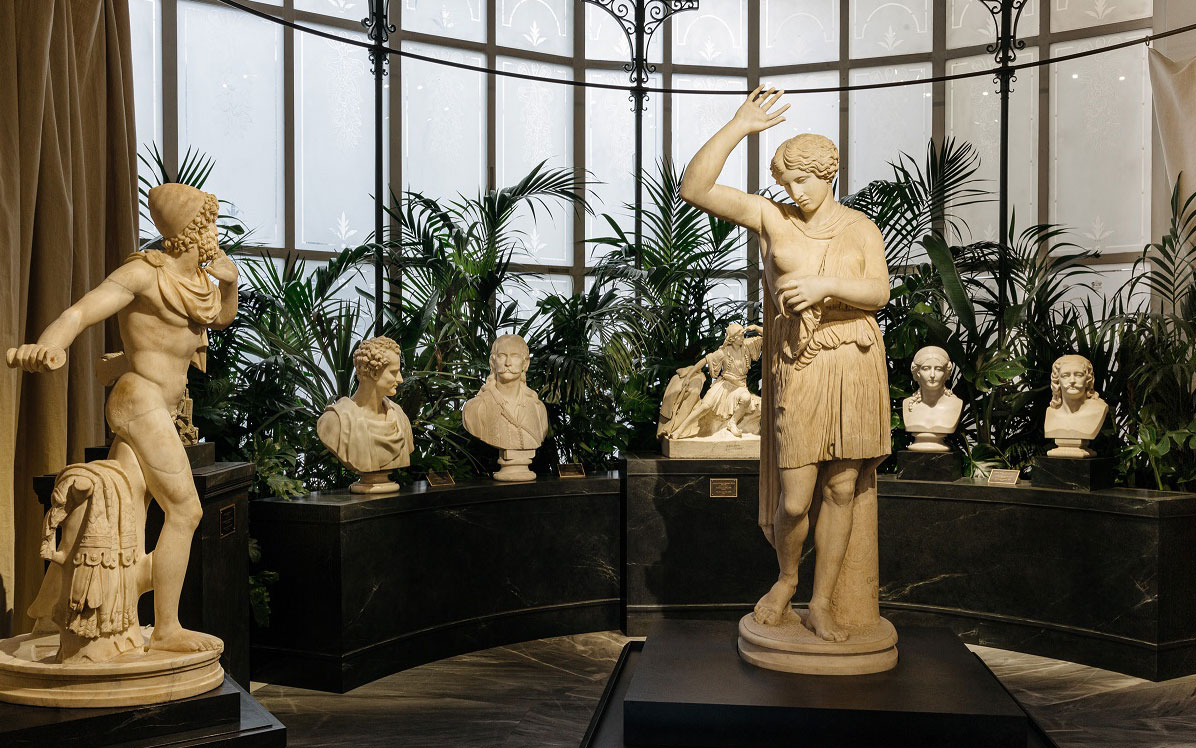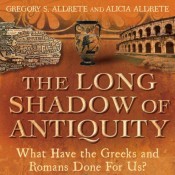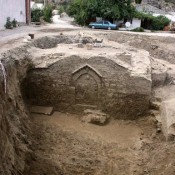On the occasion of the bicentennial of the Greek Revolution of 1821, the Museum of Cycladic Art presents the exhibition Antiquarianism and Philhellenism: The Thanassis and Marina Martinos Collection in the Stathatos Mansion. Rare and original in its concept, the exhibition includes important nineteenth-century European and Greek Neoclassical works, in dialogue with ancient masterpieces, and is curated by art historian Dr. Fani-Maria Tsigakou and Professor Nikolaos Chr. Stampolidis.
Organized in collaboration with the Ministry of Culture andSports, co-organised with and sponsored by the AEGEAS Non-Profit Civil Company for Culture and Social Welfare, the exhibition will open to the public as soon as museums open their doors to the public.
In the meantime, visitors from anywhere in the world have the opportunity of enjoying the exhibition digitally with free access to a specially-designed microsite.
The Exhibition
The exhibition is in 3D in its entirety, exactly as it is presented in the actual space in the Stathatos Mansion. Visitors can explore digitally all the objects displayed, while explanatory texts and detailed descriptions of the works complement the virtual tour. They can also watch a video in which the curators guide them to selected exhibits.
The overwhelming majority of pieces displayed are from the Thanassis and Marina Martinos Collection, a unique treasure trove of Philhellenic chefs d’oeuvre, which is presented to the public for the first time. These are European, philhellenic artistic creations, as well as works by Greek artists inspired by subjects of antiquity, in dialogue with authentic antiquities from major museums in Italy and Greece, such as the CapitolineMuseums of Rome, the National Archaeological Museum of Venice, the Ostia Archaeological Museum, the National ArchaeologicalMuseum in Athens, Ancient Eleutherna, and the Rethymnon Archaeological Museum.
The exhibition Antiquarianism and Philhellenism: The Thanassis and Marina Martinos Collection is part of the “Dialogues” which the Museum of Cycladic Art has established in recent years. These are conversations between artworks that bridge different periods, revealing influences of the past in the present. Aim of the organizers is not merely to mount a historical or anniversary exhibition, or to approach the period through the military events, but to enhance two major currents, of Antiquarianism and Philhellenism, the one generative cause and the other fertile consequence, which aided the 1821 War of Independence and the founding of the Greek State.
The exhibition focuses on the antiquarian aspects of the philhellenic movement, before, during, and after the Revolution. Antiquarianism was the most enduring link between Europeans and Greece. In the course of the Revolution, it was transformed into Philhellenism and was imprinted visually in European artworks, while after the creation of the Greek State it was adopted by Greek Neoclassical artists in their endeavour to show the unbroken continuity of the ancient Hellenic heritage.
The exhibition includes 60 works from the Martinos Collection – oil paintings, sculptures, and diverse art objects such as figureheads, clocks, decorative porcelains, furniture, jewellery, urns, a wallpaper panorama, an embroidery, and a fan. Also displayed are five antiquities and one cast of Roman antiquity.
Dialogs
The selected philhellenic works capture the presence of ancient Hellas through antique motifs alluding to the ancestral legacy which the Greek freedom-fighters were defending and which at the same time was inspiring them in their cause.
From the “dialogues” of exhibits, the visitor’s eye is captivated by the emblematic marble statue of a wounded Amazon, from the CapitolineMuseum of Rome, a work of the second century AD, which is a Roman copy of a fifth-century BC Greek original, in all probability by the sculptor Polykleitos, in dialogue with the wooden figurehead in the form of an Amazon, from the Martinos Collection, a late eighteenth-century work by the French carver Douin Pete. The small second-century AD stone statue of Athena, from Ancient Eleutherna and the Rethymnon Archaeological Museum, confers with the early nineteenth-century figurehead with Athena, in the Martinos Collection. The cast of the bust of General Themistocles, of the second century AD, from Ostia Archaeological Museum, recalls the figurehead of Themistocles of the early nineteenth century from the Collection, while the statuette of Odysseus from the National Archaeological Museum of Venice is interlocutor with Βenedetto Sangiovanni’s sculpture of Odysseas Androutsos with his dog, of 1836. Last, the first-century AD herm of Sappho with the inscription «ΣΑΠΦΩΕΡΕΣΙΑ» (Sappho Eresian), from Capitoline Museum of Rome, and the Attic red-figure hydria with representation of a female musician (Sappho) of 440-430 BC, from the National Archaeological Museum in Athens, are in dialogue with the Collection’s table clock Madame de Stael as Sappho, of 1830.
The ancient masterpieces discourse with their Neoclassical versions inside the emblematic Stathatos Mansion, splendid example of Greek Neoclassical architecture, designed by Ernst Ziller, which was the home of the family of Othon and Amalia Stathatos until 1938. The public will have the unique opportunity of seeing the interior of an actual haut bourgeois European residence of the nineteenth century, while living a theatrical experience.
The space has been transformed by Chloe Obolensky, who signs her first set design for a museum exhibition, together with Andreas Georgiadis.
A few words about the period
The heritage of ancient Hellas was for the intelligentsia of Europe the fount of models, human values, education, culture and aesthetics. During the eighteenth century of the Enlightenment, European adulators of antiquity emphasized the similarities between the Modern Greeks and their ancient ancestors. The spirit of antiquarianism, basic component of the Philhellenic movement, fired the imagination of romantic artists, who projected the virtues of the ancient heroes onto the freedom-fighters of the Greek Revolution. In the images they created, Greek chiefs of armedirregulars are inscribed alongside the heroes of the ancient Hellenic pantheon.
In addition to the visual arts and romantic literature, represented by such luminaries as Eugène Delacroix, René Chateaubriand, P. B. Shelley, Lord Byron, Victor Hugo, and others, other minor arts too contributed to the globalization of Philhellenism, with utilitarian or ornamental objects, giving rise to an “industry” that popularized the historical events and so widened the philhellenic movement: furniture, porcelains, tableware, table clocks, decorative vases, embroideries, fans wallpapers. These simplified and easily readable transcriptions of historical representations upon objects and the emergence of the “philhellenic fashion”, played their part in familiarizing public opinion with the Greeks’ Struggle. These objects, which were purchased in shops or at “philhellenic” markets and bazaars, inundated private houses and public buildings of the period.
Moreover, the enhancement of the unbroken continuity of the Modern Greeks with their ancient forebears and heritage was the basic axis offorging the identity of the Greek State, which ardently strove to link itself with the Western, European family, and defined the aesthetic choices ofGreek art in the newly-founded State.
This particular exhibition, in addition to its original conception, is exceptionally important for the semantics of its content, as it negotiates the encounter between Greece and Europe, an issue of seminal importance today.
The private collection formed by Thanassis and Marina Martinos, part of which is presented to the public for the first time, is one of the fullest assemblages of philhellenic objects. The historical and aesthetic value of the works in it is the natural outcome of the Martinos family’s long-standing involvement with art. The “MARTINOS” antique shop has been supplying precious historical items to cultural foundations, museums and private collections, in Greece and abroad, for over 100 years.
The exhibition is organized in collaboration with the Ministry of Culture and Sports, co-organised with and sponsored by the AEGEAS Non-Profit Civil Company for Cultural and Social Welfare.



